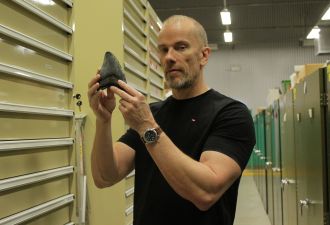Media release
From:
New scientific paper disputes body shape of extinct megalodon shark
The Western Australian Museum was part of an international team of 26 leading shark palaeontologists and neontologists who have challenged a recently published interpretation of the body shape of the megatooth shark Otodus megalodon.
Otodus megalodon (also referred to as Carcharocles megalodon) is an extinct shark species that lived 16-3.5 million years ago. WA Museum’s Head of Earth and Planetary Sciences Dr Mikael Siversson said that previous research depicted the shark species with a stocky body shape like that of the white shark and other lamnid species, but with the new study disputing this body shape interpretation.
“The mismatch between the stocky build of Otodus megalodon in published palaeoartistic reconstructions and the surprisingly small diameter of the largest known vertebral centra of this species has bothered me for a long time.
“The species had in fact an unusually slender vertebral column, which is at odds with previous reconstructions depicting megalodon as a girthy shark,” Dr Siversson said.
The only fossil material available of this enormous shark comprises associated dentitions, a relatively complete vertebral column and isolated vertebrae and shed teeth.
“Although we have a very good idea about the size of the mouth from associated dentitions seemingly including all tooth positions, other anatomical features such as the shape of the fins and tail are unknown, Dr Siversson said.
“It was refreshing to see such broad and strong support among my peers for a more strictly evidence-based view on the anatomy of this iconic species of extinct shark.
“Going forward, any meaningful discussion on the anatomy of this shark other than the size and robustness of the jaws would require the discovery of more-or-less complete skeletons,” Dr Siversson said.
Multimedia





 Australia; WA
Australia; WA


